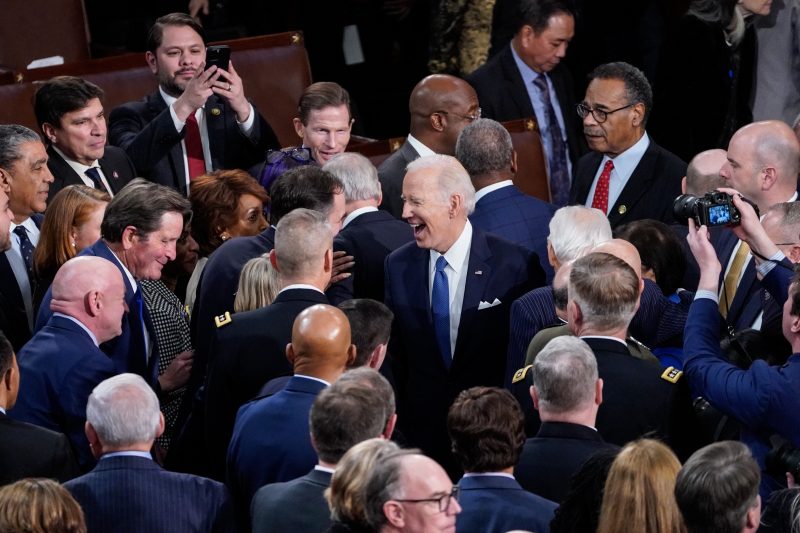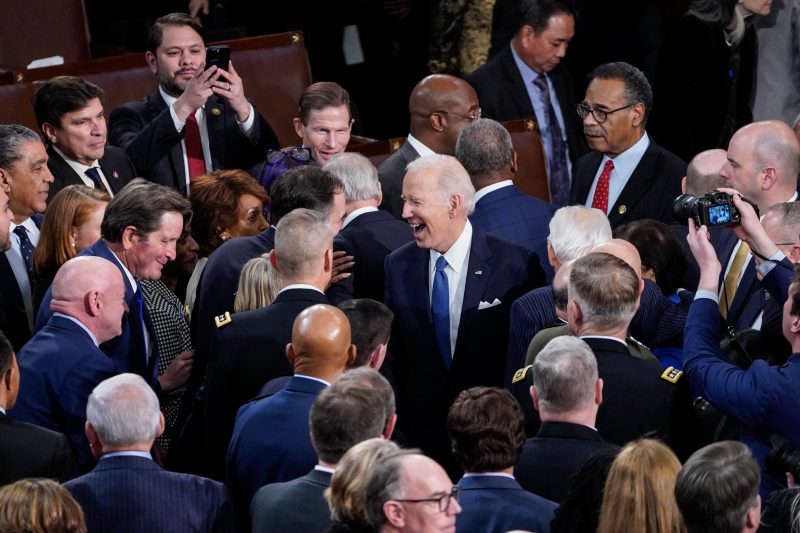
President Biden heads into his third State of the Union address on Thursday rather unpopular — and with key voters more than a bit concerned about his age and his ability to steadily guide the country for another four years. He is about even or narrowly trails former president Donald Trump in early polls of their now-solidified rematch.
As The Post’s Matt Viser notes in his preview of the speech, Biden often responds to his doubters with a two-word phrase: “Watch me.”
So to the extent Americans are watching him assume the bully pulpit on Thursday at 9 p.m. Eastern, what does he need to show them?
At the top of that list is vibrancy. Biden’s campaign and Democrats can complain all they like that concerns about Biden’s age are some kind of media construct, but those concerns were pronounced long before this became a major narrative.
And there’s no sign the worries are going away. A Quinnipiac University poll last month showed two-thirds of Americans — including nearly half of Democrats — said Biden was too old to effectively serve another term. (Just 4 in 10 Americans said the same of Trump.)
A New York Times/Siena College poll this week isolated the degree of the concern. Even among those who voted for Biden in 2020, 61 percent at least somewhat agreed he was “just too old” to effectively serve, with 26 percent agreeing with that statement “strongly.”
The poll then went deeper, asking those voters whether he was still capable of handling the job; 19 percent of Biden 2020 backers said he would not only be less effective in a second term, but that it’s such an issue that he’s “not capable of handling the job of president.”
These are telling findings. Most of these voters will very likely vote for Biden anyway. But there is some drop-off, with Biden getting less support than in 2020. And the fact that so many of Biden’s own supporters express a high degree of concern about his age says something; voters usually downplay the liabilities of their chosen candidates.
About the best thing Biden can do to allay anxieties is to volley with reporters or with Trump in a debate; a scripted speech is only going to go so far. But the process starts with actually addressing the elephant in the room rather than pretending it’s not there or that people don’t really care about it as much as they clearly do.
Another vital theme to watch is how Biden starts making his election-year economic pitch.
There are clearly lots of good signs — including on unemployment, the stock market and consumer confidence — but reduced-but-still-prominent inflation looms large. Voters also aren’t giving Biden much credit for the good stuff, and they recall Trump’s economy much more fondly.
A CBS News-YouGov poll over the weekend showed 65 percent said the economy under Trump was good, but just 38 percent said it’s currently good. Perhaps most significant: Fifty-five percent of those polled said Biden’s policies would make prices go up, while 34 percent said the same thing about Trump’s policies.
Inflation is the economic boogeyman stalking Biden. He will reportedly use his speech to blame greedy corporations and possibly cite their “shrinkflation” as culprits for prolonging the pain.
Such populism can be effective, but voters tend to attach whatever the circumstances are to the president, fairly or unfairly. And shifting blame is probably less important than making an effective case that Americans are, all things considered, better off than four years ago and moving in the right direction.
Republicans handed Biden plenty to work with when they killed a bipartisan border security deal last month. Now he needs to drive home that they bear responsibility for perhaps his most problematic policy issue.
Both Republicans’ actions and some of their comments suggested the deal was rather cynically killed to keep the border chaotic and as a potent political issue in November. Republicans said legislation was necessary, but then they suddenly said Biden could handle it himself.
All of this is fodder for Biden to argue that Republicans bear blame for the continued chaos. But it’s very difficult to point to the inner workings of Congress in a way that penetrates. For now, it’s clear Americans weren’t exactly clamoring for the deal and don’t see it as especially tough, but they do blame Republicans more. And that’s something, if Biden can make people process it all.
Ukraine is similarly situated — though in this case Biden’s speech is more important for the future of Ukraine than for his political future.
The American public, writ large, is clearly on Biden’s and Ukraine’s side when it comes to continuing to help it fend off Russia’s invasion. Just 36 percent in an AP-NORC poll this week wanted a less active roll in the conflict. A foreign aid bill with Ukraine funding passed with 70 votes in the Senate last month, including 22 Republicans.
But a significant faction of the right is balking at continued funding, and House Speaker Mike Johnson (R-La.) doesn’t appear to have a game plan beyond not voting on what the Senate did.
Biden’s problem here is that the Republican supporters of Ukraine funding are a lot less animated than the measure’s GOP opponents. Biden surely won’t be able to change that dynamic, but he could reinforce to the American public and reluctant Republicans like Johnson the potential costs of inaction in allowing Russia to win.
The election results of the past two weeks make clear Biden has some work to do in navigating the very complex issue that is the war in Gaza.
After supporters of the Palestinian cause urged people to protest Biden’s handling of the war by voting “uncommitted” in Democratic contests, that option got 9 percent in Colorado, 13 percent in Michigan and a whopping 19 percent in Minnesota. It then got 29 percent in Hawaii’s low-turnout caucuses on Wednesday.
Again, Democrats are minimizing the significance of this, noting that the general-election alternative is Trump, with his even stronger alliance with Israel and his anti-Muslim comments. But clearly this is and has been a fraught issue for Biden, given how much it divides his party roughly in half and the possibility that Democratic-leaning voters support a third-party candidate or stay home.
The groups that are most aligned with the Palestinians also happen to be the groups with which Biden underperforms the most: young people and Black and Hispanic voters. As many as half of Democrats disapprove of his handling of the war — again, a striking number.
Biden has scaled back his strong early support for Israel’s war effort. And his administration has ramped up delivery of humanitarian aide to Gaza; tonight he’ll announce the U.S. will build a temporary port for aid.
But there are no great options for him on this one. And politically, this is most likely about damage limitation.

